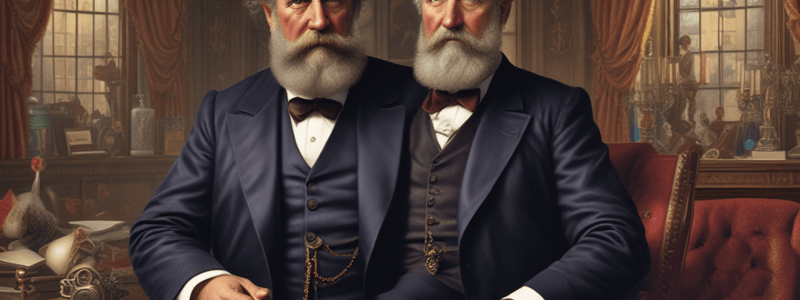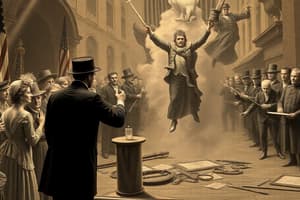Podcast
Questions and Answers
Which industry was led by Cornelius Vanderbilt?
Which industry was led by Cornelius Vanderbilt?
- Steel industry
- Banking industry
- Railroad industry (correct)
- Oil industry
What was the main method used by Rockefeller and Carnegie to acquire wealth?
What was the main method used by Rockefeller and Carnegie to acquire wealth?
- Labor union negotiations
- Political lobbying
- Expansion into international markets
- Vertical Integration (correct)
Who among the rich businessmen believed in Social Darwinism, advocating 'Survival of the Fittest'?
Who among the rich businessmen believed in Social Darwinism, advocating 'Survival of the Fittest'?
- Rockefeller (correct)
- John Pierpont Morgan
- Andrew Carnegie
- Cornelius Vanderbilt
Which business practice involves owners in competition creating rules and regulations they all follow?
Which business practice involves owners in competition creating rules and regulations they all follow?
Who is known for selling his company Carnegie Steel to J.P. Morgan?
Who is known for selling his company Carnegie Steel to J.P. Morgan?
'Robber Baron' is a term referring to a person who acquired wealth through what kind of business practices?
'Robber Baron' is a term referring to a person who acquired wealth through what kind of business practices?
Which technology inventor created a system of communication using dots and dashes called Morse Code?
Which technology inventor created a system of communication using dots and dashes called Morse Code?
'Gospel of Wealth' stated that rich people are meant to help poor people. Who wrote this book?
'Gospel of Wealth' stated that rich people are meant to help poor people. Who wrote this book?
What was the main innovation by Thomas Edison that allowed people to travel or work at night in safer conditions?
What was the main innovation by Thomas Edison that allowed people to travel or work at night in safer conditions?
Who was the political figure in New York City associated with the corrupt Tammany Hall?
Who was the political figure in New York City associated with the corrupt Tammany Hall?
What was the purpose of the Pendleton Act of 1883?
What was the purpose of the Pendleton Act of 1883?
Which industry was led by John D. during this time period?
Which industry was led by John D. during this time period?
What economic system characterized the Gilded Age?
What economic system characterized the Gilded Age?
Who believed he was crucial to Garfield's presidency and assassinated him due to not getting a job through the spoil system?
Who believed he was crucial to Garfield's presidency and assassinated him due to not getting a job through the spoil system?
Which industry had railroads as their primary method of transporting goods?
Which industry had railroads as their primary method of transporting goods?
What was the main focus of the Merit System introduced by the Pendleton Act?
What was the main focus of the Merit System introduced by the Pendleton Act?
Which term best describes a hands-off approach to business practiced by the government during this era?
Which term best describes a hands-off approach to business practiced by the government during this era?
What was Gilded defined as in the text?
What was Gilded defined as in the text?
Which of the following was NOT a key industry during the Gilded Age?
Which of the following was NOT a key industry during the Gilded Age?
What was the primary purpose of the Sherman Anti-Trust Act of 1890?
What was the primary purpose of the Sherman Anti-Trust Act of 1890?
Which of the following was a key tactic used by unions to achieve their goals?
Which of the following was a key tactic used by unions to achieve their goals?
What was the primary goal of the American Federation of Labor (AFL) when it was founded in 1886?
What was the primary goal of the American Federation of Labor (AFL) when it was founded in 1886?
Which union organization was known for accepting both skilled and unskilled workers?
Which union organization was known for accepting both skilled and unskilled workers?
What was the primary tactic used by companies to counter the influence of unions?
What was the primary tactic used by companies to counter the influence of unions?
Which major labor dispute in the late 19th century involved the American Railway Union and the Pullman Company?
Which major labor dispute in the late 19th century involved the American Railway Union and the Pullman Company?
What was the primary outcome of the Haymarket Riot in 1886?
What was the primary outcome of the Haymarket Riot in 1886?
Which of the following was a common tactic used by companies to undermine union efforts?
Which of the following was a common tactic used by companies to undermine union efforts?
What was the primary goal of the Knights of Labor organization?
What was the primary goal of the Knights of Labor organization?
Which of the following was a major factor that led to the rise of labor unions in the late 19th century?
Which of the following was a major factor that led to the rise of labor unions in the late 19th century?
Study Notes
The Gilded Age
- The term "Gilded Age" refers to a fake gold layer covering something rotten, symbolizing the corruption and exploitation during this time period.
Political Machines
- A political machine is an organized group that controls a city's political party.
- William "Boss" Tweed led one of the worst political machines in New York City, operating from Tammany Hall.
- Charles Guiteau assassinated President Garfield, believing he deserved a job due to the spoil system.
- Chester A. Arthur became President and passed the Pendleton Act in 1883, requiring civil service job qualifications.
Big Business
- From 1870-1900, politics were corrupt, and the government allowed wrongdoing for the right price.
- Increase in capitalism led to the development of industries, including railroads, steel, and oil.
- The railroads enabled efficient travel of goods and created a national market.
Railroads
- By 1865, there were 35,000 miles of track; by 1900, there were 193,000 miles.
- Railroads were the biggest customers for steel tracks.
Steel Industry
- Developed cheap and efficient methods of producing steel.
- Later used to build skyscrapers.
Oil Industry
- Led by John D. Rockefeller, the oil industry used railroads to transport goods.
- Oil was separated into gasoline and kerosene.
Unions
- American Federation of Labor, created in 1886 by Samuel Gompers, accepted skilled labor and demanded better conditions.
- Knights of Labor, created in 1863 led by Terence Powderly, accepted skilled and unskilled labor.
- Unions used strikes, boycotts, and negotiations with employers to achieve their goals.
Strikes and Riots
- 1877: Railroad strikes led to 100+ deaths.
- Haymarket Riot (1886): A bomb was thrown during a strike, leading to 11 deaths.
- Pullman Strike (1894): Led by Eugene V. Debs, the strike slowed down trains nationwide and ended with government intervention.
Big Business Leaders
- John D. Rockefeller (Standard Oil): Worth over $400 billion, believed in social Darwinism.
- Andrew Carnegie (Carnegie Steel): Worth over $350 billion, sold his company to J.P. Morgan, and wrote "The Gospel of Wealth."
- Cornelius Vanderbilt (Railroad Industry): Led the development of railroads.
- John Pierpont Morgan (Banking Industry): Bought U.S. Steel, AT&T, and Edison Company.
Big Business Methods
- Horizontal Integration: Buying out competition to control a single industry area.
- Vertical Integration: Controlling all phases of production from raw materials to finished products.
Monopolies and Trusts
- Monopoly: One business owning an entire market (e.g., Google).
- Trust: A business practice where competitors create rules and regulations (e.g., price fixing).
Robber Barons or Captains of Industry
- Robber Baron: A person who became rich through ruthless business practices.
- Captain of Industry: A business leader whose means of amassing wealth contributed positively to the country.
Inventions and Technology
- Telegraph: Allowed communication through Morse Code.
- Telephone (1876): Enabled voice-to-voice communication.
- Lightbulb (Thomas Edison): Enabled safe and efficient nighttime work and travel.
- Bessemer Process: Allowed for cheap steel manufacture, used by Carnegie.
- Labor for Big Business: Immigrants from Eastern and Southern Europe and Asia provided a steady supply of workers, often facing harsh racism and criticism.
Studying That Suits You
Use AI to generate personalized quizzes and flashcards to suit your learning preferences.
Description
Test your knowledge on political corruption during the Gilded Age, including the definition of 'gilded', political machines, and infamous figures like Boss Tweed and Charles Guiteau.




